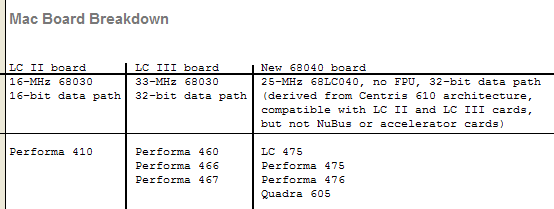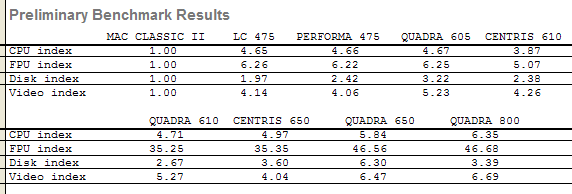| As the year winds down, Apple is announcing its latest
harvest — a batch of new desktop Macs, a pair of
PowerBooks, and two workgroup printers. The new products
are accompanied by a series of marketing shuffles intended
to reduce confusion over the Mac line and increase its
visibility in the market. Although experienced PC shoppers are used to confronting a bewildering array of nearly identical computers, it's been only a few years since Apple's entire catalog consisted of just three or four basic Macs. Now Macs are proliferating so prodigiously that even the experts have trouble remembering the difference between, say, a Performa 400 and a 405, or between a PowerBook 165 and a 170. Unfortunately, the wider range of choices is confusing some potential Mac buyers. Apple's latest announcements appear even more baffling: • Centris, Apple's year-old label for midrange Macs, has been dropped. Apple has consolidated its computers into four distinct brands: Performa, LC, Quadra, and PowerBook. Performas are targeted at the home market, LCs are for education, Quadras are for business users, and PowerBooks are for mobile users. • The former Centris 610 and 650 now have faster processors and are called Quadras. They are joined by a new low-end model, the 605, that's the first Quadra without either a NuBus slot or a NuBus-adaptable PDS (Processor Direct Slot). • Apple's most successful Macs have been the LC models, which debuted in 1990. In fact, International Data Corp. ranks the LC III as the best-selling personal computer in the world. But instead of capitalizing on the LC's popularity and name recognition, Apple has decided to not let consumers buy them anymore. Under Apple's new marketing strategy, the LC is restricted to educational channels. Consumers will be redirected toward Performas or Quadras. • Seven new Performas have been introduced, some nearly indistinguishable from one another. For example, the only differences between the 466 and 467 are their bundled software and retail channels. Still confused? There's a solution: Sort out the different models by their main logic boards. A handful of basic logic boards span the various labels and determine such critical features as performance, expandability, and upgrade paths. 68030-Based Macs The low end of the Macintosh line will be anchored by the new Performa 410. It's really an LC II main logic board in Performa's clothing. The 410's only significant new feature is its floppy drive. All new Macs now sport the same drive found in current PowerBooks. It's functionally identical to the old SuperDrive but no longer grabs the disk and pulls it into the drive during insertion. It still auto-ejects the disk and remains compatible with Mac and PC 3-1/2-inch formats. It also has a dustproof door. Three new Performas are based on the LC III main logic board: the Performa 460, 466, and 467. The only important difference is the 68030 CPU, now clocked at 33 MHz instead of 25 MHz. Other specs remain the same. Only the hardware configurations, bundles, and retail channels separate these three models. Software bundles also vary slightly. Street prices are expected to range from $1300 to $1400. Rounding out the 68030-based line is the new Performa 550, a consumer version of the all-in-one LC 520 introduced to educational channels last summer. There are two notable differences: It has a 33-MHz 68030 instead of the LC 520's 25-MHz CPU, plus a 160-MB hard drive. 68040-Based Macs Four new Macs share a freshly designed 68040-based main logic board that spans the Performa, LC, and Quadra brands (see the table "Mac Board Breakdown"). Derived from the Centris 610 architecture, the new board has an FPU-less 25-MHz 68LC040, a 32-bit data bus, 4 MB of on-board RAM (expandable to 36 MB via 72-pin SIMMs), and 512 KB of VRAM (expandable to 1 MB). It supports 8-bit video on monitors measuring up to 21 inches, and 16-bit video on 16-inch and smaller screens. The processor is mounted on a socket on the main logic board. This lets you remove the processor and install a 68040 if your needs demand it. Unlike the logic board in the Centris 610, however, the new logic board has a notched PDS connector that accepts either 96-pin LC II or 114-pin LC III cards. A special ASIC (application-specific IC) presents 68030 processor signals to this socket, making it compatible with LC-series cards. However, since it provides no direct access to the 68040 processor bus, there's no way to adapt a NuBus card to this connector or add an accelerator. The main logic board is also smaller than the 610's, sized to fit inside the standard LC "pizza-box" case. New Macs based on this main logic board include the LC 475, Performa 475 and 476, and Quadra 605. Again, these models are distinguished by their bundles, configurations, and retail outlets. The LC 475, for instance, is available only through educational channels at steep discounts. Unlike the Performas, the Quadra 605 isn't bundled with a monitor, keyboard, modem, or software. That means it's the lowest-priced Mac that lets you choose your own components, such as a third-party monitor or an extended keyboard. A basic configuration with 4 MB of RAM and an 80-MB hard drive starts at about $919. Apple's unified approach to main logic boards obviously benefits the bottom line: One board fits into four computers. Of course, this also means you get nearly identical performance, a fact borne out by the BYTE low-level benchmarks. Preliminary results indicate that despite the different names, the LC 475, Performa 475/476, and Quadra 605 are virtually the same computer. Next up the ladder are the new Quadra 610 and 650. They're virtually identical to the discontinued Centris 610 and 650 except for slightly faster CPUs. The base-configuration Quadra 610 has a 25-MHz 68LC040 instead of the Centris 610's 20-MHz processor, and the Quadra 650 has a 33-MHz 68040 (with FPU) instead of the Centris 650's 25-MHz 68CL040 (without FPU). Also, Ethernet is now standard, rather than optional. Street prices are expected to start at $1369 for a Quadra 610 with 8 MB of RAM and a 160-MB hard drive. The Quadra 650, with 8 MB of RAM and a 230-MB hard drive, should sell for about $2280. Note that these prices are preliminary, estimated street prices. Low-level benchmarks indicate that the Quadra 610 is approximately 20 percent faster than the Centris 610, and the Quadra 650 is about 25 percent faster than the Centris 650. The Quadra 610 benchmark results closely match those of the Quadra 605 except for floating-point performance, because the version we tested had a 68040 processor installed. Although the Quadra 610's specifications and performance appear quite similar to those of the Quadra 605, Performa 475/476, and LC 475, remember that, despite their identical 25-MHz CPUs, they're based on different main logic boards. The 610 has a 68040 PDS that's convertible to a 7-inch NuBus slot; it's expandable to 64 MB of RAM; and it has room for a 51/4-inch internal storage device, such as a CD-ROM drive. Apple plans to make upgrades available to owners of most LC-series and Performa computers with pizza-box cases by late November. The $599 upgrade includes the new 68LC040-based main logic board and System 7.1. Upgradable systems are the LC II and III and the Performa 400, 405, 410, 430, 450, 460, 466, and 467. Mac Board Breakdown
 Preliminary Benchmark Results
 Photograph: Apple's new Quadra 610 is available with two processors — either an FPU-less 25-MHz 68LC040 or a 68040, which has a built-in FPU. Copyright 1994-1997 BYTE |